Chinatown, Kuala Terengganu
Kampung Cina (Jawi: كامڤوڠ چينا; Simplified Chinese: 唐人坡, Pe̍h-ōe-jī: tn̂g-lâng-pho), is a Chinatown located in Kuala Terengganu, Terengganu, Malaysia. Kampung Cina is located along Jalan Bandar (formerly known as Jalan Kampung Cina), in Kuala Terengganu city centre at the river mouth of Terengganu River that empties into the South China Sea. Kampung Cina literally means Chinese Village; it is also called Teng Lang Po or KT's Chinatown by local people. It is one of Southeast Asia's early Chinese settlements and contains stately ancestral homes, temples, townhouses, and business establishments. The town is small but has colourful shophouses along both sides of the road that carries traditional flavour.
| Chinatown, Kuala Terengganu | |||||||||||||||||
|---|---|---|---|---|---|---|---|---|---|---|---|---|---|---|---|---|---|
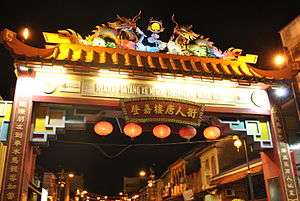 The gate of Kampung Cina on the southern end of Jalan Bandar | |||||||||||||||||
| Traditional Chinese | 唐人坡 | ||||||||||||||||
| Simplified Chinese | 唐人坡 | ||||||||||||||||
| |||||||||||||||||
Kuala Terengganu's Chinatown was first established by the Chinese community in the late 19th century. It was once a hub for commercial activities that helped shape Kuala Terengganu into what it is today. The Chinese built the traditionally designed shop houses according to their place of origin in China.
History
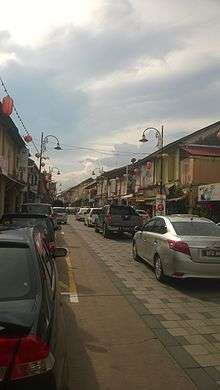
Kampung Cina, Chinatown of Kuala Terengganu is the main Chinese settlement in Kuala Terengganu, situated near the heart of Kuala Terengganu city centre. In 1719, the Chinese village settlement had more than 1000 house compared from its today row of pre-war Chinese shop houses of that which only dated as far as 200-year or its earlier dated that are recorded by foreigners like Alexander Hamilton and Captain Joseph Jackson who visited the Chinese settlement while in the Kuala Terengganu town during 1719, and other like J. Newbold in 1893, Munshi Abdullah in 1836, and more.[1] The great fire in early 1880s destroyed a large part of the area and subsequently, many of the houses were rebuilt.[2][3]
The exact date of the founding of Kampung Cina is not clearly known as no archaeology dig was ever made, as to preserve the Kampung Cina site which is now a part of the city. Many who live here may be descended from the first Chinese who arrive and settled here at Terengganu since the 16th century.[1] Thus many of its occupants treat their house as an ancestral home which has much history after being handed down from generation to generation. Nowadays, preservation and modification projects are carried out on many of the old buildings.
Evidence of the early presence of Chinese settlers in Kampung Cina
When Alexander Hamilton and Captain Joseph Jackson visited Kuala Terengganu in 1719–20 and 1764 respectively, the presence of Chinese settlers was noted down in their records. Alexander wrote:[4]
Trangano ........ about one thousand houses in it, not built in regular streets, ....... The Town is above half-peopled with Chinese, who have a good trade for three to four Jonks yearly, ....... The product of the country are Pepper and Gold, which are mostly exported by the Chinese. About 300 tons are the common Export of Pepper, ........
— Alexander Hamilton.
According to the Malay scholar Munshi Abdullah, who visited Kuala Terengganu in 1836, there was a large Chinese quarter with a Kapitan Cina (Chinese leader) named Kapitan Lim Eng Huat (1798-1847), who was the third Kapitan of Chinatown. He probably saw the concrete bridge being built during Sultan Mohammad's period (1837-1839) because in his second visit here, Munshi wrote about the bridge in 1838.
Kuala Terengganu was also described by Thomas John Newbold in 1839:
... the Malay town of Tringanu in 1828 was large and populous .... The Chinese are numerous, and live principally in strong brick-built houses, which now exhibit every appearance of an old and long established colony. The Chinese population of the town is estimated at 600, that of the Malays from 15,000 to 20,000.[5]
— Thomas John Newbold, English soldier, traveller and orientalist.
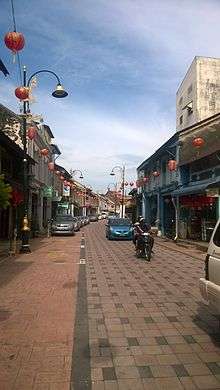
Various Chinese records and annals - dated as far back as the 10th century (Song Dynasty) have referred to the ports of Terengganu. Javanese records of the Kingdom of Majapahit in the 14th century also placed Kuala Terengganu on their list of trading centres. But no one really know the exact dated of the Chinese settlement in Kampung Cina. It is only certain with evidence that the Chinese settlement may started in Terengganu after Admiral Cheng Ho (Zheng He) of China return to China between 1419AD to 1719AD or maybe before or around the time of Alexander Hamilton and Captain Joseph Jackson who visited Kuala Terengganu in 1719–1720.
It is believed that Admiral Cheng Ho (Zheng He) of China - the Goodwill Ambassador of the Ming Dynasty - led a huge fleet of about 200 vessels with approximately 28,000 marine officers and crew to the shores of Kuala Terengganu in the year of 1414 AD. This is based on evidence from a map of places visited by Cheng Ho, during his fourth trip to the west.
Right after the visit of Cheng Ho/Zheng He, Chinese farmers from the coast of China, especially the people from Zhangzhou District of Hokkien Province sail to Terengganu first settled at Bukit Datu (Big City), and along the river bank of Nerus River. The Chinese's forefathers in Terengganu named Nerus River as Sampokang (Cheng Ho's River) and built a temple at Kampung Jeram - Sampokong Keramat Cheng Ho.[4]
The Chinese population of Chinatown mainly did their trade in the waterfront area. These settlers were engaged in trades through concessions from the state rulers, and among their businesses included the sale and bartering of crafts such as textiles, metalwork, and woodwork from the nearby Malay communities, and commercial trades, imports, and exports of goods (such as silks, gambir, camphor, pepper, and gold) from local or foreign places.[2]
By the mid-1800s, with the booming of the tin mining and industries, the Chinese population of Kuala Terengganu and the whole Malaya increased tremendously as new Chinese immigrants arrived here for work. Kuala Terengganu, which is strategically located on the east coast of Peninsula Malaysia, was a natural stopping point for those who plied the trade route from China to South East Asia in the early days. Those who fall in love with this enchanted land simply stay on while the rest, sail on to fulfill their own destiny, in places like Perak and Kuala Lumpur for tin mining. Kampung Cina became the most densely populated area for the Chinese community in Kuala Terengganu.
Architecture
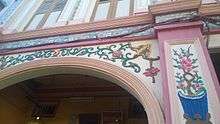
Chinatown was opened about 300 years ago by the traders from Southern China and was the first area for business and trading in Kuala Terengganu, although in its current form, the oldest building (many of which are shophouses) dates back from the late 1800s.[6] Today, there are about 270 pre-war Chinese shophouses.[7] Many of these shophouses were originally built with brick, plaster, and timber. Currently, due to the old age of these structures, refurbishments and renovations are carried out to a number of buildings.
The early Chinese residents chose to build the shophouses near the bank of Terengganu River since the location provides a place for junks and ships to harbour.[8] Like a typical Chinatown in other Malaysian states, the buildings incorporate various styles such as traditional Southern Chinese designs,[2] Neoclassical, or Art Deco.[9] The façades of these shophouses differ according to their styles. Neoclassical buildings, for instance, are rather elaborate and ornate in its decorations, while older buildings are generally bare and simple.
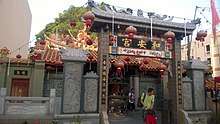
Each shophouse of Chinatown is not singular building. Instead, many different shophouses are connected to one another and form one long structure. A number of back alleys separate these structures. The shophouses in Chinatown are both commercial and private structures, mostly two storeys high. Families who own business establishments (such as sundry shop, light industry, or warehouse) usually will use the ground floor for the business and trade and reside on the upper floor.[10][11] The common element of many of these shophouses is the covered passageway in front of the buildings known as kaki lima or the 'five-foot-way'. The name comes from the original prescribed width of the passageway, which is five feet, although later regulations prescribed a width of seven and a half feet.[10]
Culture

The culture in Chinatown has been one that is an admixture of the Malay and Chinese traditions and lifestyles. Chinese traditions and customs can be found everywhere in this place and Chinese new year is celebrated widely by the Chinese residents. The influence of local Malay culture in Terengganu also gave rise to the small Peranakan community locally known as Mek and Awang. This community is quite similar to the Penang and Malacca counterparts known as Baba and Nyonya, but still retains its own uniqueness and differences. Mek and Awang community is centred in two main places, Chinatown, and Kampung Tiruk, a village about 14 km from Kuala Terengganu.[12]
Similar to Baba and Nyonya in Penang and Malacca, the traditional costume of the Terengganuese Peranakan women is a special type of Kebaya known as Kebaya potong kot. Ornamental broidery is typical of this Kebaya.[13]
The Chinese dishes (especially the Peranakan dishes) are influenced by the local East Coast culture. Among the influence is the usage of budu), a fish sauce made from anchovies. Local Chinese or Peranakan dishes that can be found here include ayam pachok, akok, rojak ceranang, roti paung dan pulut lepa.[7][14][15] The kopitiams, cafes and restaurants that are available here offer local delicacies, mostly Chinese, but also Malay and Indian food.
As the name implies, the residents and business traders of Chinatown are mostly Chinese although nowadays, there are other Malay or Indian traders.[14] Small grocery shops, butcher shops, hardware shops, kopitiams (literally means coffee shops), cafes, restaurants and so on can be found there. Many of the businesses have been operating here for decades and are handed down to the new generations of traders.
Attractions
In the year 2004, The Government declared that Kampung Cina's various historical structures and area was to be gazetted as a heritage site of Terengganu. As a significant area of the city's Chinese community, it is home to two Chinese temples, Ho Ann Kiong and Tien Hou Kong, which was built in 1801 and 1896. Ho Ann Kiong contains a statue of the Goddess of the sea, Mazu. Unfortunately, a fire broke out that ultimately destroyed 60% of the temple. A restoration was carried out and now Ho Ann Kiong functions again.[16] Another landmark is the 19th-century Low Tiey water well, erected in 1875. It was believed to have been excavated and constructed in 1875 by Low Tiey Lim Keng Hoon (1820-1882) as a public service to the community. It was built with two separate bathing chambers for men and women with a six-metre high wall.[7] After years and years, it still supplies clean water to Chinatown's residents.
Many of the buildings here have undergone restoration or beautification programmes to make them more appealing, but without destroying the heritage value.[17] While the shophouses still retain their distinctive characteristics, they are now brighter and livelier. One can still see repair works being carried out on several shophouses. Murals can be found in many sections of the area. The recent attractions in Kampung Cina are its back alleys, many of which are transformed into thematic lanes. For example, Turtle Alley, the narrowest back lane, has information related to various turtles and turtle-themed wall and floor mosaics. Tauke Wee Seng Hee Cultural Lane is another such thematic lane. This alley showcases an old, colonial-era telephone booth and a classic cast iron post box (still in use) painted in bright red. The walls also displays a collection of old signs from shops in Chinatown and several Han Dynasty-era poems. These lanes have become tourist and photography spots.[18][19]
Kampung Cina is also known for its local delicacies such as roti paung, a special local bread, durian cake, pulut 'dipa' and the white keropok lekor, which is made of wolf herring or ikan parang. Many local Chinese dishes, along with other Malay and Indian fares, can be found in the restaurants and food courts located here. As per usual with many other cities in Malaysia, modern restaurants and cafes are also available.
Image gallery
- Gallery of street view images of Chinatown, Kuala Terengganu
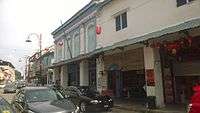 The shophouses near Pasar Besar Kedai Payang.
The shophouses near Pasar Besar Kedai Payang. The row of shophouses.
The row of shophouses.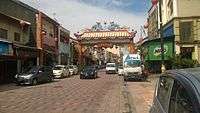 The gate of Chinatown.
The gate of Chinatown.
References
- "Why early Chinese settlers chose the site". The Star. 9 August 2007. Retrieved 9 August 2007.
- "Saving Kampung Cina in Terengganu". New Straits Times. November 1999.
- "19th century trading post at Kampung Cina". New Straits Times. February 2000.
- Morfologi Bandar Kuala Terengganu (Report). Department of Town and Village Planning of Peninsular Malaysia, Ministry of Housing and Local Government. December 2009.
- Thomas John Newbold (1839). Political and Statistical Account of the British Settlements in the Straits of Malacca: Viz. Pinang, Malacca, and Singapore, with a History of the Malayan States on the Peninsula of Malacca. J. Murray. pp. 62–.
- Norhaspida Yatim (19 November 2012). "Kampung Cina amat bernilai" (in Malay). Sinar Harian. Retrieved 15 March 2015.
- Teresa Yong-Leong (14 February 2013). "Kampung Cina, then and now". New Straits Times. Archived from the original on 22 February 2015. Retrieved 15 March 2015.
- "Legasi 300 tahun - Warisan unik penempatan minoriti Tionghua" (in Malay). Kosmo!. Archived from the original on 23 February 2015. Retrieved 15 March 2015.
- Ho Kah Chun; Dr. Ahmad Sanusi Hasan; Norizal M Noordin (September 2005). "An Influence of Colonial Architecture to Building Style and Motifs in Colonial Cities in Malaysia". School of Housing Building and Planning, Science University of Malaysia, Penang. 'Atiqah Nadiah Mohamad Hanafiah on Scribd. Retrieved 15 March 2015.
- Wan Hashimah Wan Ismail; Associate Professor Dr. Shuhana Shamsuddin (September 2005). "The Old Shophouses as Part of the Malaysian Urban Heritage: The Current Dilemma" (PDF). (Department of Architecture, Faculty of Built Environment University of Technology, Malaysia) - (Centre for Diploma Program, UTM City Campus). Archived from the original (PDF) on 17 July 2011. Retrieved 12 April 2015.
- "Chinese Architecture". HBP USM. Archived from the original on 29 January 2013. Retrieved 15 March 2015.
- Joseph Kaos Jr (2 September 2014). "Terengganu to showcase Peranakan community". The Star. Retrieved 15 March 2015.
- "Khazanah Kebaya Kampung Cina" (in Malay). Kosmo!. 29 September 2012. Archived from the original on 22 February 2015. Retrieved 15 March 2015.
- Carolyn Hong (2 February 2015). "The Peranakans of Terengganu". The Straits Times. Retrieved 15 March 2015.
- "Tahun Melawat Terengganu: Dewan Perniagaan Cina tonjol budaya peranakan" (in Malay). Sinar Harian. 2 January 2013. Retrieved 15 March 2015.
- Sazali M. Noor (24 February 2010). "200-year-old temple destroyed in night blaze". The Star. Retrieved 15 March 2015.
- Farik Zolkepli (14 August 2012). "Kuala Terengganu Chinatown a tourist draw". The Star. Retrieved 15 March 2015.
- Joseph Kaos Jr (30 June 2014). "Terengganu's unlikely tourist spots". The Star. Retrieved 15 March 2015.
- "Lokasi merakam fotografi pegun" (in Malay). Kosmo!. Archived from the original on 2 February 2015. Retrieved 15 March 2015.
External links
| Wikimedia Commons has media related to Chinatown, Kuala Terengganu. |